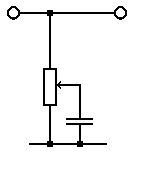Tone controls
Under tone controls or equalizer (English: tone control ) is the electronic filter circuits in radios , amplifiers and other audio devices as well as electrically amplifiable musical instruments such as electric guitar and bass , with which the user timbre can adjust the audio playback .
Accurate technology should be of sound plates or sound adjustment speak, since no regulatory mechanism exists, but only manual controls can be made. The concept of regulation is mainly used in linguistic usage because humans close the control loop.
variants
Over time, on the one hand, the circuits have developed in terms of effort, which has increasingly moved into generally affordable regions. On the other hand, the requirements changed in view of the existing signal quality and the technical possibilities.
Bezel
The simplest variant is a low-pass filter for damping high frequencies. In the early days of broadcasting, with predominantly medium wave reception and receivers with electron tubes , there was immense interference from superimposed noise and hissing. This could be eliminated to a certain extent with a sound screen. The user can adjust the degree of filtering with a single potentiometer . In addition to the potentiometer, a single capacitor is sufficient for the circuitry .
Sound balance
Here the user can set with a single potentiometer whether the depths or heights should be preferred.
Center turner
A kind of sound balance (see above), which was used for movies and recordings, was called a “center turner”. A center frequency of 800 Hz was left fixed, while the frequencies were lowered or raised in opposite directions by 60 Hz and 10 kHz.
Bass and treble controls
This is the most widespread variant to this day. The user has two potentiometers available. With one he can increase or decrease the low range, with the other the high range. In terms of circuitry, the setting is implemented using simple RC networks . Such filters become even more efficient if they are inserted into the negative feedback branch of an amplifier circuit. The point of intersection between the treble and bass controls is often lower than 1 kHz because, according to the amplitude statistics of the music, the sound center is somewhat lower; (600 to 800 Hz). The center frequency of the HiFi frequency range is also below 1 kHz. Treble and bass controls according to Peter Baxandall , known as "Baxandall tone controls", "shelving filters" or "shelf filters", are mainly used; Also called cowtail filter in technical jargon .
Bass, presence and treble controls
Here, a third adjustable presence filter for the middle frequency range is added to the two adjusters for bass and treble . This is why this adjuster is sometimes labeled as a "center control". This variant was only used in a few, mostly higher-quality devices.
Equalizer
With an equalizer, the frequency range is divided into many individually adjustable frequency bands , or filters with an adjustable slope are available ( parametric equalizer ). This enables an adaptation to the individual requirements and listening habits when consuming music, or a targeted change of the sound image in the studio. With a graphic equalizer , the controls are designed as sliders so that their position directly represents a rough image of the current frequency response.
Presets
In addition to the analog controls listed above, there are - mostly in addition - switchable presets that configure the frequency responses for typical applications such as "jazz", "speech", "orchestra" etc. without the user having to adjust all the controls himself.
stereo
In a stereo system , these filters must be installed in parallel in each channel. Tandem versions are then used as potentiometers for setting . Even higher channel counts as 5.1 - surround sound but are no longer feasible in this way.
Digital technology
In many devices - example: car radios - audio processing is now carried out exclusively digitally along the entire signal chain. The tone control is also implemented digitally by filter algorithms in digital signal processors (DSPs). The expansion to, for example, 5.1 channels (surround sound) does not mean any particular additional effort. The basic concept with separate depth and height adjusters and possibly presets is still used because it has proven itself and can be operated intuitively. However, an equalizer can also be implemented relatively easily, only the operation becomes more complex. This type of tone control is particularly efficient in MP3 players, as they require a powerful DSP and subroutines for Fourier inverse transformation anyway (in MP3 files the data is already in the phase space) and the deterioration of the sound due to digital signal processing is hardly noticeable in addition to the compression artifacts.
Semi-digital tone controls
Semi-digital tone controls are often used in CD players. These tone controls are made up of physical components and are controlled by digital signals. So-called semiconductor relays or semiconductor potentiometers are used for this purpose: circuits made of field effect transistors that behave linearly like relays or potentiometers at the operating point. The advantage is that semi-digital tone controls can be easily remotely controlled - remote controls are standard on CD players - but, in contrast to software tone controls, require far less computing power and do not degrade the sound quality.
Web links
- Amplitude statistics of music (PDF file; 177 kB)
- Determination of the center frequency of the hi-fi range from 20 Hz to 20 kHz
- The James-Baxandall Passive Tone Control Network (Engl.)
- Negative Feedback Tone Control - Wireless World, October 1952. (English; PDF; 1.7 MB)



